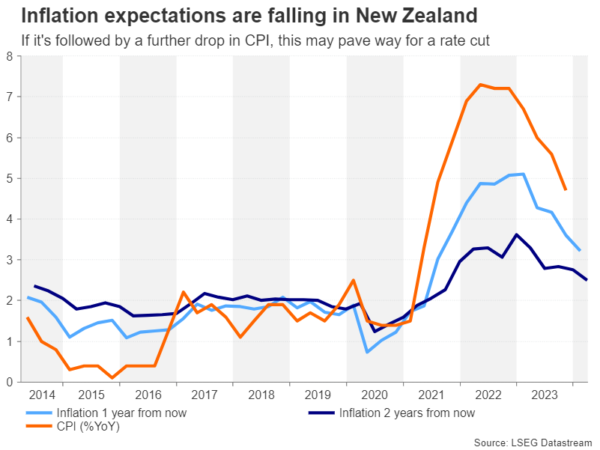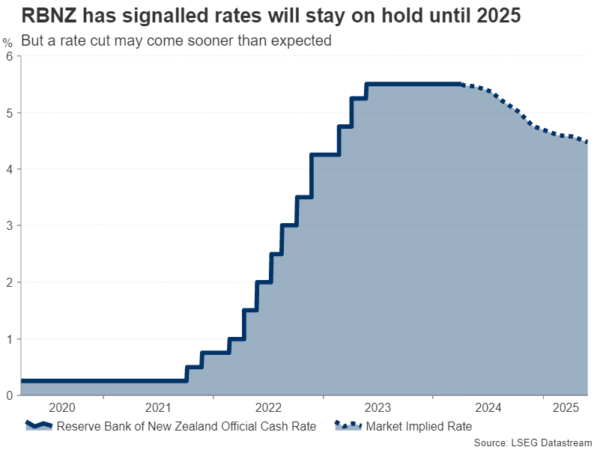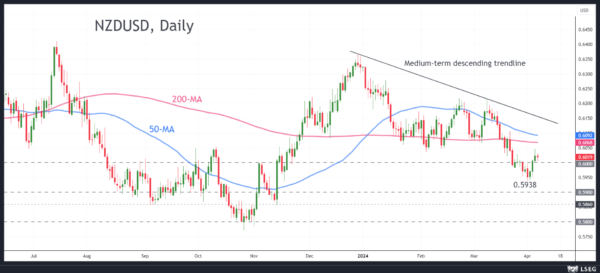- A dovish shift seems to be underway at the Reserve Bank of New Zealand
- Technical recession and falling inflation may pave way for 2024 rate cut
- Is a dovish hold on the cards at Wednesday’s meeting (02:00 GMT)?
Weaker economy has been good news for inflation
New Zealand’s economy shrunk in the final three months of 2023, entering a technical recession for the second time in 15 months. In the bigger picture, economic growth appears to have stagnated, much like in Europe and the United Kingdom. For policymakers, this is probably seen as a necessary price for bringing inflation under control, and all the indications are that it is working.
Inflation fell to 4.7% in Q4 and there was likely a further drop in the consumer price index in the first few months of 2024 as the RBNZ’s own measures of inflation expectations continued to decline in the first quarter.

Things have also been moving in a ‘satisfactory’ direction for the labour market. Worker shortages started to ease after more migrants were allowed to enter the country following the reopening of the borders in 2022. The unemployment rate has been steadily edging higher, reaching 4.0% in Q4 versus the post-pandemic low of 3.2%. More importantly, wage growth has been moderating, falling to 3.9% in Q4.
Rate cuts may come sooner than anticipated
Governor Adrian Orr even went as far as acknowledging in recent remarks that the conditions for cutting rates are becoming more apparent. Meanwhile. the Bank’s chief economist, Paul Conway, signalled back in March that a Fed rate cut towards the end of this year would make it easier for the RBNZ to follow suit if it leads to an appreciation in the New Zealand dollar versus the greenback.
At the last meeting, policymakers had projected that rates could begin to fall sometime in the middle of 2025, significantly later than the current market pricing of August 2024 for a 25-basis-point cut. There will be no updated forecasts at the April meeting, nor a press conference by Orr, but there’s likely to be some clues in the statement about whether or not committee members are becoming more optimistic about inflation falling within the 1-3% target band sooner than anticipated.

Specifically, the language will possibly reveal whether the expected decision to keep the policy rate unchanged at 5.50% will signal another dovish tilt after the Bank adopted a somewhat more neutral stance at the February meeting.
Kiwi on the slide
And this will likely determine the market reaction in the local dollar. The kiwi has come under pressure lately, slipping to four-and-a-half-month lows against the US dollar. Should the language of the statement be more dovish than expected, the kiwi could breach the April 1 low of $0.5938 and head for the $0.5900 mark. A drop below this level would bring $0.5860 into view before targeting the $0.5800 area that supported prices in October 2023.

However, if policymakers maintain their caution over the inflation outlook and the need for a prolonged period of restrictive policy, the kiwi could rebound towards its 200-day moving average, currently at $0.6068, before aiming for the medium-term descending trendline.
Yet, for the kiwi to stage a meaningful rebound, the Fed would first have to start its easing cycle and additionally, China’s economic recovery would have to gather more pace. This would create the ideal conditions for a rally, potentially offsetting any selling pressure from a more dovish RBNZ.









